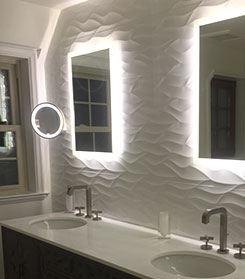Hiring a Kitchen or Bath Designer Short Hills, NJ
 Three types of design professionals offer helpful services for anyone planning a kitchen or bathroom remodeling project. If you've already got a detailed plan, many design professionals are willing to review existing designs and make suggestions, for an hourly consultation fee.
Three types of design professionals offer helpful services for anyone planning a kitchen or bathroom remodeling project. If you've already got a detailed plan, many design professionals are willing to review existing designs and make suggestions, for an hourly consultation fee.
• An architect can oversee engineering and design, including a building's structural, electrical, plumbing, heating, ventilating, air-conditioning, and mechanical systems. Most architects charge $50 to $100 per hour; or, if the project is large, an architect may charge a percentage of the project's overall cost.
• An interior designer, or a designer who specializes in kitchens and baths, can't help with engineering details but can help with layout, choice of materials, and the way the room will look and function. Look for certification by the National Kitchen and Bath Association (NKBA). Evidence of certification means the designer has completed and mastered rigorous instruction, including certified training programs in room layout, storage planning, cabinet installation, plumbing, and lighting.
• A designer/builder can both design and build the project. Hiring such a firm or individual can help ensure a smooth transition from dreams to reality. Some designer/builders, however, are short on design skills and long on building expertise, while in other cases, design talent and training don't necessarily come with technical skills.
The scope of your project will help you decide which kind of professional to consult. Jobs such as replacing bathroom fixtures or kitchen cabinets don't require an architect's skills. If your renovation involves remodeling an oddly shaped, cramped, or other geometrically complicated space, however, an architect may be able to advise you better than anyone.
Ask family and friends for references. Personal referrals are a great way to obtain a list of professionals to consider.
Interview several candidates. Look at portfolios of their work; better still, arrange to see some of their work in person. This will give you an idea of the scale of rooms they've worked in and the types of ideas they've implemented. Get references and talk to past clients whenever possible.
Check credentials. Make sure your candidates thoroughly understand kitchen or bath design. Cabinet salespeople, interior designers, and architects may not match the expertise of someone with specialized training or extensive experience in kitchen or bath design. You can find certified designers in your area via the National Kitchen and Bath Association (877-NKBA-PRO).
Do your homework. Whether you're hiring a designer for hourly consultation or looking for someone to coordinate the project from start to finish, be prepared. Develop a list of goals for the remodeling, and have a rough budget in mind as well. (See next page for how to find inspiration.)
Draw up a plan. Show the dimensions and layout of your existing space and make a mock-up of what you're envisioning. This way, a potential designer will understand the scale of your project.
Clear communication with your architect, designer, and/or contractor is the best way to ensure you get what you want (and are paying for). Pictures can be invaluable when it comes to conveying your intent.
Start collecting visual images that embody aspects of what you want your kitchen or bathroom to look like. Keep a notebook or folder for ideas you like and photos that show your favorite design and product possibilities.
It doesn't hurt to have some photos of rooms you dislike as well; just be sure they're clearly marked that way before your designer looks at your notes.
Attend open houses and take notes; visit showrooms and pick up manufacturers' brochures. Then you'll have plenty of concrete examples to help you communicate your ideas and preferences to your contractor, designer, or both.
From the information you compile, develop three lists:
• On one, write down all the features you definitely want to include.• On the second, note any features you know you don't want.
• Finally, compile a wish list of items to be included if the space in your home and bathroom and your budget allow.
• It's a good idea to add up a rough budget, too, before you start interviewing professionals. Do plenty of browsing in hardware stores, home centers, and bathroom-furnishings shops to see what things cost.
• Don't knock things off your initial wish list just because of money. You can always pare down your wish list later to fit the budget; the time to dream is in the beginning.
View Source
Interested in new tiles for your kitchen or bathroom?
Come check out our line or products!
Click Here
Read More Articles




